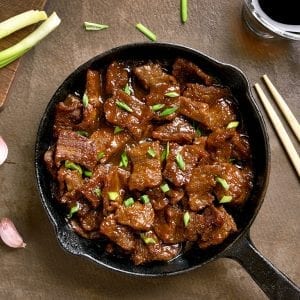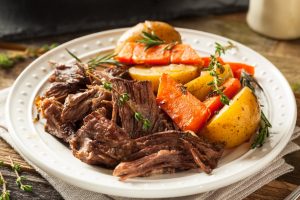Indulge in the savory taste of Mongolian beef with this P.F. Chang's copycat recipe. This flavorful dish offers a delectable blend of tender flank steak infused with the richness of soy sauce, the zing of ginger, and the sweetness of brown sugar. It's a foodie favorite that you can easily recreate at home.
Most ingredients in this recipe are commonly found in homes, with the exception of ginger and flank steak. You might need to visit the supermarket for these. Fresh ginger is often found in the produce section, and it imparts a unique zestiness that powdered versions can't substitute. Flank steak, on the other hand, is a flavorful yet lean cut of beef. If not available, you can substitute it with other tender cuts such as sirloin.
Key Ingredients for Mongolian Beef Recipe
Oil: Used to cook the garlic and ginger and to pan-fry the beef. Any neutral-tasting oil like canola or vegetable will suffice.
Ginger: Provides a distinctive spicy and aromatic flavor to the sauce.
Garlic: Adds a savory depth to the sauce.
Soy sauce: The main flavoring agent in the sauce, giving it a deep, savory taste.
Water: Dilutes the soy sauce and helps in the consistency of the sauce.
Brown sugar: Balances the saltiness of the soy sauce and adds a touch of sweetness.
Flank steak: A lean and flavorful beef cut, ideal for quick cooking.
Cornstarch: Helps to coat the beef for a crispy exterior and also thickens the sauce.
Green onions: Gives a fresh and pungent kick, and also adds a splash of color to the dish.
One reader, Kerrin Philips says:





This Mongolian beef recipe is a game-changer! The flavors are spot on, and it's so easy to make. It's become a family favorite, and I love that I can recreate the P.F. Chang's experience at home. Highly recommend trying it out!
Essential Techniques for Making Mongolian Beef
How to prepare the sauce: Combine the ginger, garlic, soy sauce, water, and brown sugar in a small pan and bring to a boil. Simmer for 3 to 5 minutes until slightly thickened, then set aside.
How to slice the flank steak: Cut the flank steak into ¼-inch slices and toss with cornstarch, ensuring each slice is lightly coated.
How to cook the beef: Heat oil in a pan or wok over medium-high heat. Cook the beef in small batches for about 2 minutes, ensuring it is cooked evenly.
How to combine the beef with the sauce: Once all the beef is cooked, combine it with the prepared sauce and heat over medium heat until hot and bubbly.
How to serve: Remove from heat, stir in green onions, and serve the Mongolian beef over rice.
How To Make Mongolian Beef (P.F. Chang Coypcat)
Mongolian beef is known for its savory and slightly sweet and smoky taste. Recreate P.F. Chang’s version of this tender dish at home for less than 1 hour.
Serves:
Ingredients
- 2tspoil,+ 2 tablespoons, vegetable or olive
- ½tspginger,minced
- 4clovesgarlic,finely minced
- ½cupsoy sauce,low sodium is best
- ¼cupwater
- ½cupbrown sugar,packed
- 1lbflank steak,or your favorite cut of beef thinly sliced
- ⅓cupcornstarch
- 2green onions,sliced
Instructions
-
Heat oil in a small pan over medium-low. Add ginger and garlic and stir just until fragrant.
-
Add soy sauce, water, and brown sugar and bring to a boil. Boil 3 to 5 minutes or until slightly thickened. Set aside.
-
Slice the flank steak into ¼-inch slices and toss with cornstarch. Gently shake off any excess.
-
Place 1 tablespoon at a time of oil in a pan or wok and heat over medium-high heat.
-
Cook the beef in small batches for about 2 minutes.
-
Once all the beef has been cooked, combine with the sauce and heat over medium until hot and bubbly.
-
Remove from heat and stir in green onions. Serve over rice.
Nutrition
- Calories: 340.48kcal
- Fat: 11.87g
- Saturated Fat: 4.10g
- Trans Fat: 0.01g
- Monounsaturated Fat: 5.29g
- Polyunsaturated Fat: 1.11g
- Carbohydrates: 30.67g
- Fiber: 0.61g
- Sugar: 17.92g
- Protein: 27.04g
- Cholesterol: 77.11mg
- Sodium: 1820.50mg
- Calcium: 67.71mg
- Potassium: 571.06mg
- Iron: 2.56mg
- Vitamin A: 3.75µg
- Vitamin C: 2.36mg
Crucial Technique for Perfecting Mongolian Beef
When slicing the flank steak, it's best to cut against the grain. This means cutting perpendicular to the long strands of muscle fiber in the meat. This will result in a more tender bite and easier chewing. Additionally, using a sharp knife will ensure clean cuts and prevent the meat from tearing.
Time-Saving Tips for Preparing Mongolian Beef
Prepare the ingredients: Gather and prepare all the ingredients and tools needed before starting the cooking process to streamline the cooking process.
Pre-slice the meat: Ask your butcher to pre-slice the flank steak to save time on slicing and preparation.
Use pre-minced garlic and ginger: Utilize pre-minced garlic and ginger to save time on chopping and mincing.
Organize your workspace: Keep your cooking area organized and clean to avoid wasting time searching for ingredients and tools.
Invest in a good quality wok: Investing in a high-quality wok can help in even cooking and reduce the cooking time.
Prep ahead: Prepare the sauce and marinate the beef ahead of time to save time during the actual cooking process.
Substitute Ingredients For Mongolian Beef Recipe (P.F. Chang Copycat)
oil - Substitute with vegetable oil: Vegetable oil is a neutral-flavored oil that can be used as a substitute for oil in this recipe. It has a high smoke point, making it suitable for high-heat cooking.
ginger - Substitute with ground ginger: Ground ginger can be used as a substitute for fresh ginger in this recipe. It provides a similar flavor and aroma, although the intensity may vary.
garlic - Substitute with garlic powder: Garlic powder can be used as a substitute for fresh garlic. It offers a convenient alternative and can be used in place of fresh garlic in various recipes.
soy sauce - Substitute with tamari: Tamari is a gluten-free alternative to soy sauce and can be used as a substitute in this recipe. It provides a similar umami flavor and saltiness.
brown sugar - Substitute with coconut sugar: Coconut sugar can be used as a substitute for brown sugar. It has a similar sweetness and can add a hint of caramel flavor to the dish.
flank steak - Substitute with skirt steak: Skirt steak can be used as a substitute for flank steak. It has a similar texture and flavor, making it suitable for this recipe.
cornstarch - Substitute with arrowroot powder: Arrowroot powder can be used as a substitute for cornstarch. It has similar thickening properties and can be used to achieve the desired consistency in the dish.
green onions - Substitute with chives: Chives can be used as a substitute for green onions. They provide a mild onion flavor and can be used as a garnish or ingredient in the dish.
Presentation Tips for Mongolian Beef
Elevate the plating: When presenting the Mongolian beef, focus on creating an elegant and visually appealing presentation. Use clean and modern plating techniques to showcase the dish's vibrant colors and textures.
Incorporate contrasting elements: Introduce contrasting elements such as vibrant green garnishes or a sprinkle of sesame seeds to add visual interest and depth to the dish.
Focus on precision: Pay attention to the placement of each component on the plate, ensuring that the dish is meticulously arranged to showcase the beauty of the Mongolian beef.
Emphasize balance: Create a balanced composition by considering the placement of the beef, rice, and sauce. Aim for a harmonious arrangement that is visually striking.
Highlight the sauce: Use a brush or spoon to delicately drizzle the rich and glossy Mongolian beef sauce around the plate, adding a touch of sophistication to the presentation.
Utilize elegant serving ware: Select elegant and refined serving ware that complements the dish, such as minimalist white plates or sleek, modern bowls, to elevate the overall presentation.
Incorporate artistic flair: Consider incorporating artistic elements, such as using a bamboo skewer to create a stylish beef roll or arranging the green onions in a visually captivating manner.
Focus on cleanliness: Ensure that the plate is clean and free of any smudges or spills, maintaining a polished and professional presentation for the esteemed judges.
Essential Kitchen Tools for Making Mongolian Beef
- Cutting board: A flat surface for cutting, chopping, and slicing ingredients.
- Chef's knife: A versatile knife used for various kitchen tasks such as chopping, slicing, and dicing.
- Wok: A versatile round-bottomed cooking vessel used in various Chinese cooking techniques, including stir-frying, steaming, pan-frying, and more.
- Small pan: Used for heating and simmering sauces, and for cooking small portions of food.
- Mixing bowl: Used for mixing ingredients, marinating, and preparing various components of a dish.
- Food tong: Used for flipping, turning, and serving food items during cooking.
- Spatula: A flat cooking tool used for flipping, spreading, and serving dishes.
- Measuring cup: Used for accurately measuring liquid and dry ingredients.
- Measuring spoon: Used for precise measurement of small quantities of ingredients.
- Cooking pot: Used for boiling, simmering, and cooking soups, stews, and pasta.
- Rice cooker: An appliance used for cooking rice and keeping it warm until ready to serve.
- Stove: A cooking appliance used for applying heat to cook food.
- Rice: A staple ingredient used as a base for serving the Mongolian beef dish.
Storing and Freezing Mongolian Beef: A Guide
- To store leftover mongolian beef, allow it to cool completely to room temperature before transferring it to an airtight container. Refrigerate for up to 3-4 days.
- When reheating, add a splash of water or beef broth to help loosen the sauce and prevent the beef from drying out. Reheat in the microwave or on the stovetop until heated through.
- For longer storage, you can freeze mongolian beef for up to 2-3 months. Place the cooled beef and sauce in a freezer-safe container or resealable plastic bag, removing as much air as possible before sealing.
- To thaw frozen mongolian beef, transfer it to the refrigerator and allow it to thaw overnight. Reheat as mentioned above, adding a bit of liquid to help reconstitute the sauce.
- It's best to store the rice separately from the mongolian beef, as the rice can become mushy when frozen and thawed. Cook fresh rice when you're ready to serve the reheated mongolian beef.
How To Reheat Leftover Mongolian Beef
Preheat your oven to 350°F (175°C). Place the leftover mongolian beef in an oven-safe dish and cover it with aluminum foil. Heat the dish in the oven for about 10-15 minutes, or until the beef is heated through. This method helps to retain the moisture in the meat and prevents it from drying out.
If you prefer to use the stovetop, place the leftover mongolian beef in a pan over medium heat. Add a splash of water or beef broth to the pan to help rehydrate the sauce and prevent the beef from drying out. Stir the beef occasionally and heat it until it's warmed through, which should take about 5-7 minutes.
For a quick and easy reheating method, use your microwave. Place the leftover mongolian beef in a microwave-safe dish and cover it with a damp paper towel. This will help to keep the beef moist during the reheating process. Microwave the dish on high for 1-2 minutes, or until the beef is heated through. Be sure to stir the beef halfway through the reheating process to ensure even heating.
If you have a steamer, you can use it to reheat your leftover mongolian beef. Place the beef in a heat-proof dish and place it in the steamer. Steam the beef for about 5-7 minutes, or until it's heated through. This method helps to retain the moisture in the meat and keeps it tender.
For a crispy texture, you can reheat your leftover mongolian beef in an air fryer. Preheat your air fryer to 350°F (175°C) and place the beef in the basket. Cook the beef for 3-5 minutes, or until it's heated through and slightly crispy on the outside. This method works best if you have a small amount of leftover beef.
Interesting Trivia About Mongolian Beef
The Mongolian beef recipe is a popular dish that originated in Taiwan and is not actually a traditional Mongolian dish. Despite its name, the recipe is a fusion of Chinese and Taiwanese cuisine, featuring tender slices of beef in a savory and slightly sweet sauce. This dish gained popularity in the United States after being introduced by the P.F. Chang's restaurant chain. It's a great example of how culinary traditions can evolve and adapt as they travel across different cultures and regions.
Is Making Mongolian Beef at Home Cost-Effective?
The cost-effectiveness of this Mongolian beef recipe largely depends on the availability and prices of the ingredients in your area. The use of flank steak and soy sauce might make it slightly more expensive, but the dish's flavor and portion size could make it worthwhile. On a scale of 1-10, I would rate this recipe a 7 for taste and simplicity. The approximate cost for a household of 4 people would be around $20-$25, factoring in the cost of flank steak, soy sauce, and other pantry staples.
Is Mongolian Beef Healthy or Unhealthy?
The Mongolian beef recipe, while delicious, is not particularly healthy due to several factors:
- The recipe calls for a significant amount of oil for frying the beef, which adds extra calories and fat to the dish.
- The sauce contains a high amount of soy sauce and brown sugar, which are both high in sodium and sugar, respectively. Excessive consumption of these ingredients can lead to health issues such as high blood pressure and diabetes.
- Flank steak, although a lean cut of beef, is still red meat, which should be consumed in moderation as part of a balanced diet.
To make this recipe healthier, consider the following suggestions:
- Reduce the amount of oil used for frying the beef, or opt for a healthier cooking method such as grilling or stir-frying with minimal oil.
- Use low-sodium soy sauce and reduce the amount of brown sugar in the sauce to decrease the overall sodium and sugar content of the dish. You can also substitute brown sugar with a natural sweetener like honey or maple syrup.
- Increase the proportion of vegetables in the dish by adding more green onions or other nutrient-dense vegetables like bell peppers, broccoli, or carrots. This will boost the fiber and vitamin content of the meal.
- Serve the Mongolian beef with a side of brown rice or quinoa instead of white rice to increase the fiber and nutrient content of the overall meal.
- Use a leaner cut of beef, such as sirloin or tenderloin, to reduce the overall fat content of the dish.
Editor's Opinion on This Mongolian Beef Recipe
This Mongolian beef recipe is a delightful balance of sweet and savory flavors. The combination of ginger, garlic, and soy sauce creates a rich and aromatic sauce that perfectly complements the tender flank steak. The use of cornstarch gives the beef a crispy texture, adding a delightful contrast to the sauce. The addition of green onions provides a fresh and vibrant finish. Overall, this dish is a wonderful representation of P.F. Chang's famous Mongolian beef, and it's sure to impress anyone who tries it.
Enhance Your Mongolian Beef Recipe (P.F. Chang Copycat) with These Unique Side Dishes:
Similar Recipes to Try If You Love Mongolian Beef
Appetizer and Dessert Pairings for Mongolian Beef
Why trust this Mongolian Beef Recipe (P.F. Chang Copycat):
This recipe is a trusted copycat version of P.F. Chang's famous Mongolian Beef. The combination of soy sauce, ginger, and garlic creates an authentic flavor profile. The use of flank steak ensures a tender and juicy texture, while the addition of brown sugar balances the savory and sweet elements perfectly. The careful process of coating the beef in cornstarch before cooking guarantees a crispy exterior. The final touch of green onions adds a fresh and aromatic finish. This recipe has been meticulously crafted to replicate the flavors and textures of the original dish, earning the trust of home cooks and food enthusiasts alike.
Was this page helpful?
Have your own special recipe to share? Submit Your Recipe Today!













